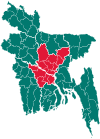Bandar Upazila
Bandar
বন্দর | |
|---|---|
UTC+6 (BST) | |
| Website | bandar |
Bandar (
Geography
Bandar is located at 23°35′35″N 090°31′13″E / 23.59306°N 90.52028°E. It has a total area of 54.39 km2. It is separated from Narayanganj Sadar Upazila and Munshiganj Sadar Upazila by the Shitalakshya River to its west and south. Bandar is bounded by Sonargaon Upazila to its north and east.[1]
History


The history of Bandar spans several centuries, and it became a principal port (bandar) not far from the medieval capitals of
After the fall of the Bengal Sultanate in the late sixteenth century, independent chieftains formed a confederacy known as the
Bandar was established as a thana in 1964. During the Bangladesh Liberation War of 1971, a mass killing was conducted in Sirajdoullah Club playground leading to the death of 54 people on 4 April. On 22 November, a brawl took place between the Pakistan Army and the Bengali freedom fighters at the banks of the Shitalakshya in Dhamgar. Another battle took place 5 days later in which a Pakistan Army gunboat was destroyed and numerous Pakistan Army soldiers killed. Defeated again on 12 December, the Pakistan Army fled to the western side of the Shitalakshya. A direct encounter took place in Bandar Railway Station where many soldiers were killed or wounded and were forced to surrender. Bandar Thana became liberated on 15 December. In 1993, Bandar Thana's status was upgraded to upazila.[1]
Demographics
| Year | Pop. | ±% |
|---|---|---|
| 1981 | 198,000 | — |
| 1991 | 213,000 | +7.6% |
| 2001 | 250,000 | +17.4% |
| 2011 | 313,000 | +25.2% |
| 2022 | 204,000 | −34.8% |
| Source: Bangladesh Bureau of Statistics[4] | ||
According to the
| Name |
|---|
| Bandar Islamia Senior Madrasa |
| Madanpur Riazul Uloom Senior Madrasa |
Administration
Bandar Upazila is divided into five
Economy and tourism
Bandar's ancient history has made it a popular place of tourism. Home to 252 mosques, noted ones include the Bandar Shahi Mosque, the mosque and mausoleum of Haji Baba Saleh and the Farazikanda Mosque. Other notable sites include the Qadam Rasul in Nabiganj and the Sonakanda Fort, both dating back several hundred years.
See also
- Upazilas of Bangladesh
- Districts of Bangladesh
- Divisions of Bangladesh
References
- ^ OL 30677644M. Retrieved 27 April 2024.
- OL 30677644M. Retrieved 27 April 2024.
- ^ সাংস্কৃতিক ঐতিহ্য. Daily Jugantor (in Bengali). 26 January 2015. Archived from the original on 29 January 2015. Retrieved 30 January 2015.
{{cite news}}: CS1 maint: unfit URL (link) - ^ a b c d "Bangladesh Population and Housing Census 2011 Zila Report – Narayanganj" (PDF). bbs.gov.bd. Bangladesh Bureau of Statistics.
- ^ "Community Tables: Narayanganj district" (PDF). bbs.gov.bd. Bangladesh Bureau of Statistics. 2011.
- ^ "History & Facts". Naryanganj City Corporation. Archived from the original on 13 December 2012. Retrieved 20 November 2020.

